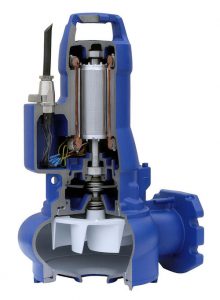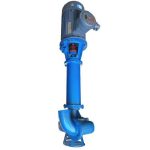How the pump works
The working principle and characteristics of the centrifugal pump
1, centrifugal pump working principle

Before the pump starts, the pump and inlet pipe are filled with water. After the pump runs, under the action of centrifugal force generated by the impeller’s high-speed rotation, the water in the impeller runner is thrown around, pressed into the volute, and the impeller inlet forms a vacuum. The water of the pool is drawn along the suction pipe under the external atmospheric pressure to supplement this space.
Then the suction of water and impeller out of the volute and into the pipe.
Thus it can be seen that, if the centrifugal pump impeller constantly rotating, can continue to absorb water, pressure water, water can be continuously from low to high or far.
To sum up, the centrifugal pump is due to the high speed rotation of the impeller produced by the centrifugal force, the water will be high, so called centrifugal pump.
2, the general characteristics of centrifugal pump
(1) The flow direction of water along the centrifugal pump is the axial suction along the impeller, perpendicular to the axial outflow, that is, the flow direction in and out of each other into 90°.
(2) Because the centrifugal pump by the impeller inlet to form a vacuum suction, so before starting must phase pump and suction pipe perfusion water, or vacuum pump air, to discharge air to form a vacuum, and the pump case and suction pipe must be strictly sealed, no leakage, otherwise no vacuum, it will not absorb water.
(3) Since it is impossible to form a vacuum at the inlet of the impeller, the suction height of the centrifugal pump should not exceed 10m. In addition to the loss caused by water flow through the suction pipe, the actual installation height (the height between the axis of the pump and the suction surface) is much less than 10m.
If the installation is too high, it will not absorb water;
In addition, because the mountainous area is lower than the plain atmospheric pressure, so the same pump in the mountainous area, especially in the high mountainous area installation, its installation height should be reduced, or can not suck up water.
The working principle and characteristics of axial flow pump
1, axial flow pump working principle
Axial flow pump and centrifugal pump working principle is different, it is mainly the use of high-speed impeller rotation produced by the thrust water.
Axial flow pump blade rotation on the water produced by the lift, water can be pushed from the bottom to the top.
The blades of the axial flow pump are generally immersed in the pool where the water is drawn.
As the impeller rotates at a high speed, under the action of the lift generated by the blade, the water is continuously pushed upward to make the water flow out along the outlet pipe.
The impeller is constantly rotating, water is also continuously pressed to high.
2. General characteristics of axial flow pump
(1) The flow direction of water in the axial flow pump is along the impeller’s axial phase suction, axial phase outflow, so called axial flow pump.
(2) Low head (1 ~ 13 meters), large flow, high efficiency, suitable for plain, lake, river network area drainage and irrigation.
(3) No irrigation is required before starting, and the operation is simple.
(3) The working principle and characteristics of the mixed flow pump
1, mixed flow pump working principle
Because the shape of the impeller of the mixed flow pump is between the impeller of the centrifugal pump and the impeller of the axial flow pump, therefore, the working principle of the mixed flow pump is both centrifugal force and lift force. Depending on the comprehensive action of the two, the water will flow out of the impeller at a certain Angle with the shaft, through the volute chamber and pipeline to the high water.
2. General characteristics of mixed flow jumping
(1) Compared with centrifugal pump, mixed flow pump has lower head and higher flow, while axial flow pump has higher head and lower flow.
Suitable for drainage and irrigation in plain and lake area.
(2) Water flow along the direction of the mixed flow pump and impeller shaft into a certain Angle and suction and outflow, so also known as oblique flow pump.

